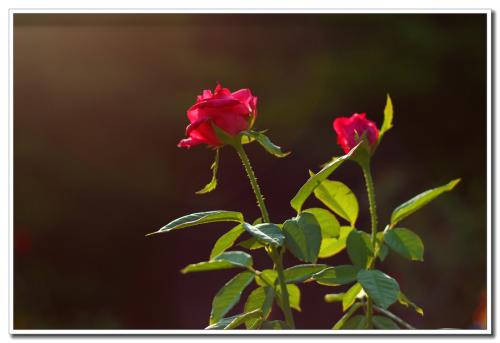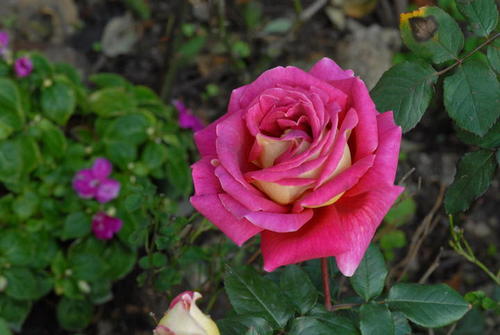How to care for rose
Written by Maggie
Jan 11 2021

Roses should be every girl's favorite flowers to receive. Many friends who grow flowers at home will also try to plant rose potted plants at home. How to care for rose heart rotten or not bloom? The following are some rose care guides.

Rose care for heart rotten
When the heart of a rose is broken, it must be treated timely to the right medicine. If improper watering, timely control watering, and watering should avoid touching the foliage. If caused by improper fertilization, carry out reasonable soil replacement treatment. Fertilizer should be poured along the root system around, but also pouring in the appropriate amount of water. If caused by poor ventilation, pay more attention to the cleanliness of the leaf, so as not to breed disease. The following are details of Rose's care for heart rotten.
Control watering
Rose is a shallow root plant. There is a certain drought tolerance. During the growth, if excessive watering, or water in the leaves, it is easy to cause the rot in the middle of the rhizome. Then how to care for the rotten heart of the rose? Stop watering in time, the rotten stem cut off. After watering, it should be poured along the edge of the basin soil.
Reasonable fertilization
The stem and leaves of rose are sensitive to fertilizer. If too much fertilizer is applied during the growth period or splashes into flowers and leaves during fertilization, it is easy to cause the stem and leaves to rot. At this time, it is necessary to stop fertilization in time.
Pay attention to ventilation
Roses like to grow in a well-ventilated environment. If the surrounding environment is poorly ventilated or dusty, it is easy to pollute the stems and leaves and cause rot and yellowing. At this time, the plants should be moved to a ventilated and sunny environment, and then more attention should be paid to the cleanliness of the leaves at ordinary times to avoid diseases.
Disease prevention
When roses suffer from leaf spot disease, root rot disease, brown spot and other hazards, the leaves will gradually wither and turn yellow, and the rhizome part is easy to rot in the case of high humidity. At this time, the infected plant should be cut off in time, strengthen the ventilation around, and spray with thin chlorothalonil or dixone solution for prevention and control.

Rose care for not blooming
When the rose doesn't bloom, we should apply the remedy to the case in time. If the lack of sun retards, plants will be moved to the ventilation sunny place, giving best long day processing. If improper temperature, good heat preservation measures to prevent bask in, control temperature about 15 ~ 25 ℃. The nutrient deficiencies are mainly under phosphorus fertilizer in front of the flower. For a few times, to provide the nutrition for the flower. The following are details of rose care for not blooming.
1. Increase light
A rose is a very bright light plant. If put in for a long time too dark and light irradiation environment to grow, it can affect the growth of the Mosaic, resulting in plants to flower. The plant should be moved to a more sunny place. Every day in front of the flower, give adequate sunlight, but under the strong light shade to process flower bud differentiation.
2. Control the temperature
The change of temperature is the main factor affecting the flowering of roses. If the growth temperature around the rose is too high, or very low, it will affect the formation of flower buds, resulting in the rose not flowering. Then how to care for the rose not flowering? It is best to control a certain temperature difference in the flowering period, control the temperature at about 15 ~ 25℃.
3. Supplement nutrients
Rose likes to grow in the soil with sufficient nutrients. If the nutrients in the soil are insufficient, or improper fertilizer, will cause the plant not to blossom, and will also affect the growth. It is best to fertilize mainly with phosphate and potassium fertilizer before the flower, a small number of times. After the flower, add 1 ~ 2 times of putrid cake fertilizer water, in order to facilitate the formation of flower buds.
4. Disease prevention
When rose suffer to leaf spot, leaf spot, the harm such as aphids, it will gradually violations rose Mosaic, influence the formation of flower bud differentiation and, lead to problems in terms of roses bloom, the strain should be cut it off and destroyed, strengthen ventilated permeability around, with a thin chlorothalonil or bordeaux mixture solution for prevention and control of spraying.

Latest Updated
- Benefits of Bugleweed - 7 Science-backed Health Benefits
- Bugleweed Dangers & Side Effects - Is It Poisonous?
- How to Plant Evergreen Trees - What You Should Know
- When to Plant Evergreens - Grow Guide for Evergreen Trees
- 12 Wonderful Evergreen Shrubs for Your Garden
- 12 Popular Evergreen Plants with Pictures for Beginners
- When And How To Prune A Lilac Bush Like a Pro
- How to Grow & Care for Lilac Vine (Hardenbergia Violacea)
- Japanese Lilac Tree (Syringa Reticulata) Care & Propagation Guide
- Shumard Oak Pros and Cons - What to Know
Popular Articles
- Winter maintenance of Antirrhinum Majus
- How to Grow Terminalia Mantaly Tree
- How to Grow and Care for Crossostephium Chinense
- How to grow Antirrhinum Majus in spring
- Peristeria Elata (Dove Orchid) Profile: Info & Care Guide
- Underwatered Snake Plant (Sansevieria Trifasciata) - Signs And How To Fix
- How to Care for Brazilian Jasmine Plant (Mandevilla Sanderi)
- How to Grow & Care for Graptopetalum Purple Delight in Summer
- Rosa Chinensis (China Rose): Plant Growing & Care Tips
- How to Care for Baby Sun Rose (Aptenia Cordifolia)